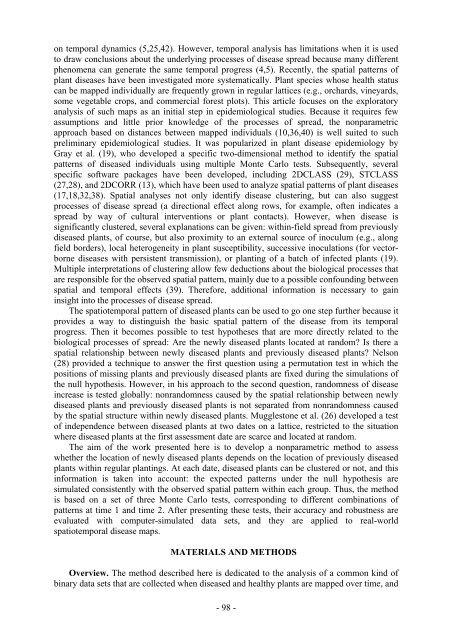Ecole Nationale Supérieure Agronomique de Montpellier ... - CIAM
Ecole Nationale Supérieure Agronomique de Montpellier ... - CIAM
Ecole Nationale Supérieure Agronomique de Montpellier ... - CIAM
You also want an ePaper? Increase the reach of your titles
YUMPU automatically turns print PDFs into web optimized ePapers that Google loves.
on temporal dynamics (5,25,42). However, temporal analysis has limitations when it is used<br />
to draw conclusions about the un<strong>de</strong>rlying processes of disease spread because many different<br />
phenomena can generate the same temporal progress (4,5). Recently, the spatial patterns of<br />
plant diseases have been investigated more systematically. Plant species whose health status<br />
can be mapped individually are frequently grown in regular lattices (e.g., orchards, vineyards,<br />
some vegetable crops, and commercial forest plots). This article focuses on the exploratory<br />
analysis of such maps as an initial step in epi<strong>de</strong>miological studies. Because it requires few<br />
assumptions and little prior knowledge of the processes of spread, the nonparametric<br />
approach based on distances between mapped individuals (10,36,40) is well suited to such<br />
preliminary epi<strong>de</strong>miological studies. It was popularized in plant disease epi<strong>de</strong>miology by<br />
Gray et al. (19), who <strong>de</strong>veloped a specific two-dimensional method to i<strong>de</strong>ntify the spatial<br />
patterns of diseased individuals using multiple Monte Carlo tests. Subsequently, several<br />
specific software packages have been <strong>de</strong>veloped, including 2DCLASS (29), STCLASS<br />
(27,28), and 2DCORR (13), which have been used to analyze spatial patterns of plant diseases<br />
(17,18,32,38). Spatial analyses not only i<strong>de</strong>ntify disease clustering, but can also suggest<br />
processes of disease spread (a directional effect along rows, for example, often indicates a<br />
spread by way of cultural interventions or plant contacts). However, when disease is<br />
significantly clustered, several explanations can be given: within-field spread from previously<br />
diseased plants, of course, but also proximity to an external source of inoculum (e.g., along<br />
field bor<strong>de</strong>rs), local heterogeneity in plant susceptibility, successive inoculations (for vectorborne<br />
diseases with persistent transmission), or planting of a batch of infected plants (19).<br />
Multiple interpretations of clustering allow few <strong>de</strong>ductions about the biological processes that<br />
are responsible for the observed spatial pattern, mainly due to a possible confounding between<br />
spatial and temporal effects (39). Therefore, additional information is necessary to gain<br />
insight into the processes of disease spread.<br />
The spatiotemporal pattern of diseased plants can be used to go one step further because it<br />
provi<strong>de</strong>s a way to distinguish the basic spatial pattern of the disease from its temporal<br />
progress. Then it becomes possible to test hypotheses that are more directly related to the<br />
biological processes of spread: Are the newly diseased plants located at random? Is there a<br />
spatial relationship between newly diseased plants and previously diseased plants? Nelson<br />
(28) provi<strong>de</strong>d a technique to answer the first question using a permutation test in which the<br />
positions of missing plants and previously diseased plants are fixed during the simulations of<br />
the null hypothesis. However, in his approach to the second question, randomness of disease<br />
increase is tested globally: nonrandomness caused by the spatial relationship between newly<br />
diseased plants and previously diseased plants is not separated from nonrandomness caused<br />
by the spatial structure within newly diseased plants. Mugglestone et al. (26) <strong>de</strong>veloped a test<br />
of in<strong>de</strong>pen<strong>de</strong>nce between diseased plants at two dates on a lattice, restricted to the situation<br />
where diseased plants at the first assessment date are scarce and located at random.<br />
The aim of the work presented here is to <strong>de</strong>velop a nonparametric method to assess<br />
whether the location of newly diseased plants <strong>de</strong>pends on the location of previously diseased<br />
plants within regular plantings. At each date, diseased plants can be clustered or not, and this<br />
information is taken into account: the expected patterns un<strong>de</strong>r the null hypothesis are<br />
simulated consistently with the observed spatial pattern within each group. Thus, the method<br />
is based on a set of three Monte Carlo tests, corresponding to different combinations of<br />
patterns at time 1 and time 2. After presenting these tests, their accuracy and robustness are<br />
evaluated with computer-simulated data sets, and they are applied to real-world<br />
spatiotemporal disease maps.<br />
MATERIALS AND METHODS<br />
Overview. The method <strong>de</strong>scribed here is <strong>de</strong>dicated to the analysis of a common kind of<br />
binary data sets that are collected when diseased and healthy plants are mapped over time, and<br />
- 98 -



